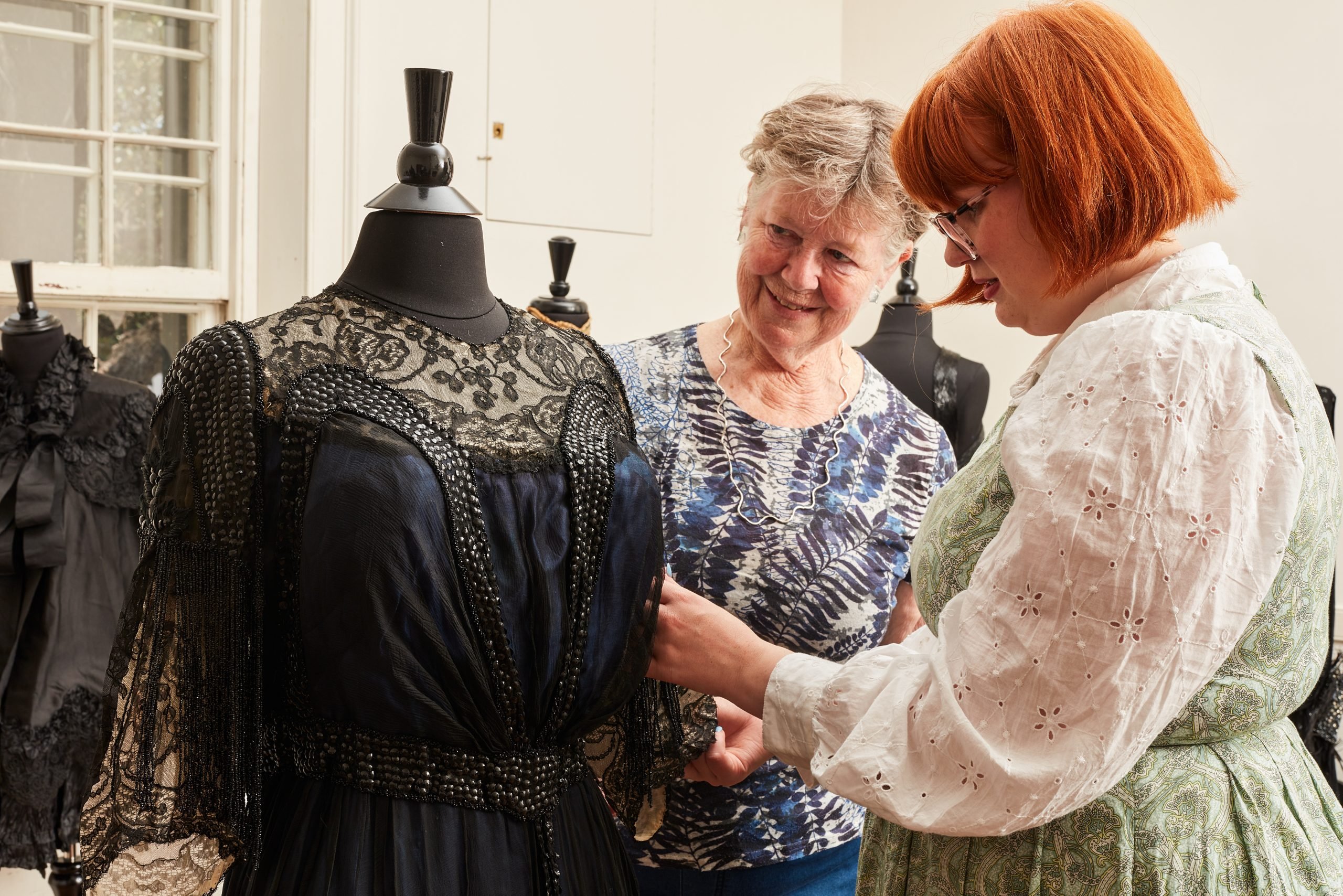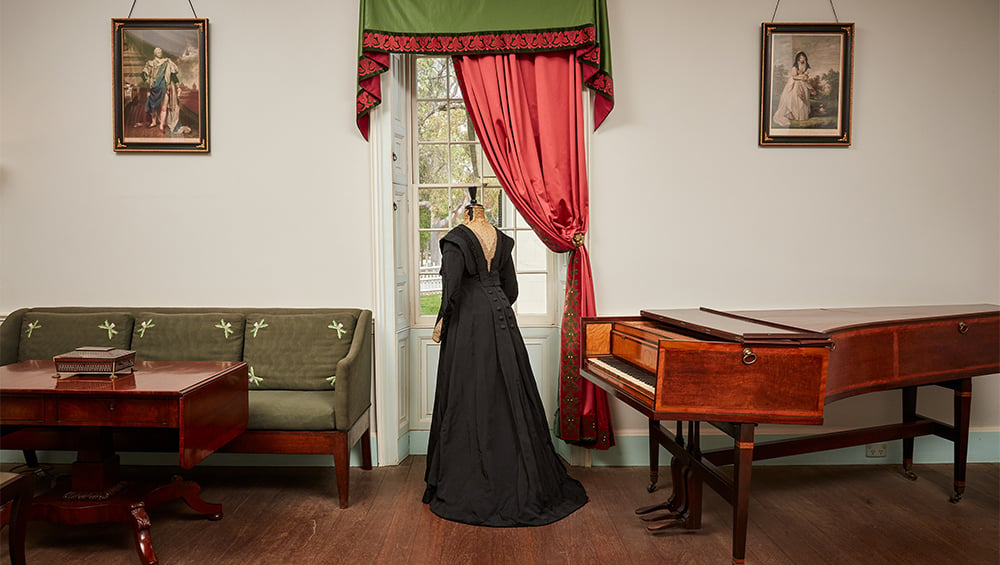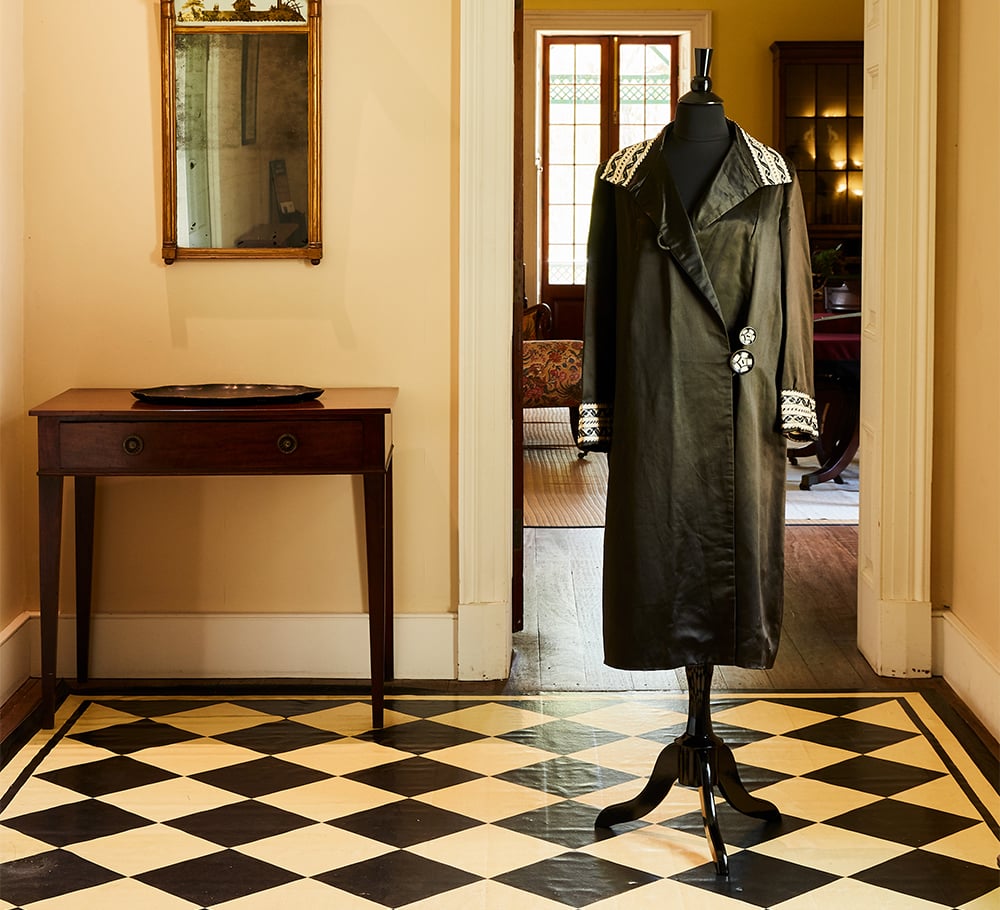Favoured by royalty, rockstars and rebels, the colour black has had a surprisingly vibrant history. With a new exhibition of black in fashion opening at Old Government House, historian Lorinda Cramer examines the meaning and history of this mercurial hue.
BY LORINDA CRAMER, DRESS HISTORIAN
This article was originally published in the January 2024 issue of the National Trust (NSW) magazine.
Few colours so readily evoke contradictory meanings as black. It can signal passion or conservatism; rebellion or authority. Black is full of drama. It is also subtle, used to blend in rather than stand out. Depending on the context, it gestures to glamour or grief, subversion or uniformity. But black wasn’t always instilled with these meanings – at least not simultaneously. I’ve been thinking about black and its colourful history for the upcoming exhibition, Back to Black, opening at Old Government House in March.
Black was worn in the ancient world and for centuries to follow, however before the invention of synthetic dyes it was largely donned by those who could afford the costly cloth. From Roman mourners and austere Benedictine monks, a luxurious black was later adopted by Europe’s wealthiest, usually royalty. Its popularity rose, fell, then rose again in the years to come.
Black was difficult to produce using only natural materials from vegetable or animal sources. A time-consuming series of dyes was applied to darken cloth to a deep blue-black. The production of a synthetic black dye in the late 1850s was highly prized – more stable, long-lasting and easier to apply than natural alternatives. As a result, black became available to the masses. Servants might wear black uniforms, paired with crisp white aprons and caps. So might professional men when they donned a black frock or morning coat, with black trousers and a top hat.

The colour of mourning
At the same time, elaborate Victorian-era mourning rituals solidified. Queen Victoria wore black from 1861 to mourn her husband, Prince Alfred. She continued to dress in black throughout the next 40 years until her own death, to express her profound loss.
Widows followed Queen Victoria’s lead, guided by etiquette around stages or degrees of bereavement that moved from full to ordinary to half mourning. Lustreless black fabrics were adopted for full mourning, unadorned but for crape trim, recognised by its crimped, stiffened appearance.
Others mourning loved ones were not as bound to the same intense display of grief as widows. Nevertheless, special sections for mourning wear developed in drapery and department stores to cater to the need for black clothes for men, women and children. They offered crape trim for bonnets and arm bands, together with a range of black cloth, jewellery and accessories.

Black in fashion
Black had begun to appear elsewhere too, including as elegant evening gowns. In the 1920s, as hemlines rose and silhouettes straightened, knee-length black dresses appeared at nightspots. They glittered with beads and sequins and were animated by feathers and fringes. Coco Chanel’s little black dress first made its mark that decade and endures as a fashion staple today. The simple, if not minimalist, lines of the little black dress were revolutionary, crossing day and evening wear.
From those sleek lines, black gowns of the 1930s and 40s gave way in the postwar period to a dramatic silhouette introduced by Christian Dior. Dubbed the New Look, its full skirt was an exciting shift from the cloth restrictions imposed during World War II.
Black continued to attract wearers in the second half of the 20th century as youth subcultures flourished. Rockers, punks, goths and other groups embraced black’s subversive power, wearing it as leather, denim or PVC. Beneath clothing, underwear was also shifting from conventional white, as more alluring black lace lingerie became available. Black continues to hold a place in many wardrobes today, as underwear, outerwear or accessories.

From wardrobe to museum
My interest in black’s fashionable twists and turns was sparked as I examined the National Trust’s dress collection in order to write a significance assessment – a document that captures why and how the collection is important. As I eagerly opened each archival box, peeling back layers of tissue paper to examine the contents, the dramatic shade appeared again and again. Black hats, shoes, fans, purses and aprons were plentiful. So were black gowns, coats and other items of dress – some worn for everyday and others for special occasions.
The Back to Black exhibition then developed to bring together these rich, lush, gorgeous examples of black clothes and accessories into a curated display that could be enjoyed by the public. The capes, or mantles as they were called in the 19th and 20th centuries, captured my attention. Some are made of black velvet and others of silk satin. One is quilted for warmth. Most are trimmed, though this ranges from tassels, lace and beads to feathers. Many are eye-catching, including those selected for the exhibition.
So are the elegant gowns that drip with beads and sequins. One, made around 1910, combines black chiffon over a vibrant blue silk satin skirt beneath – a flash of brilliance before the onset of war reduced clothing to basic, utilitarian styles.
Another gown, worn following the war in the 1920s, returns to riotous style. The beads and feathers of this knee-length gown were made to shimmer and shiver as its wearer danced. A third example, made by celebrated Parisian couturier Pierre Balmain with glamorous beaded shoulder straps, reflects his opulent style that developed after World War II. The absence of colour allows these distinct details to shine, capturing some of the many nuances and contradictions of this elegant and timeless hue.
The Back to Black exhibition features dresses from the collections at Old Government House, Grossmann House, Miss Porter’s House and the National Trust general collection.
Visit the exhibition
Back to Black runs from 15 March to Sunday 10 November 2024 at Old Government House in Parramatta.
Check exhibition opening hours and plan your visit.

 Twitter
Twitter Facebook
Facebook Linkedin
Linkedin Email
Email